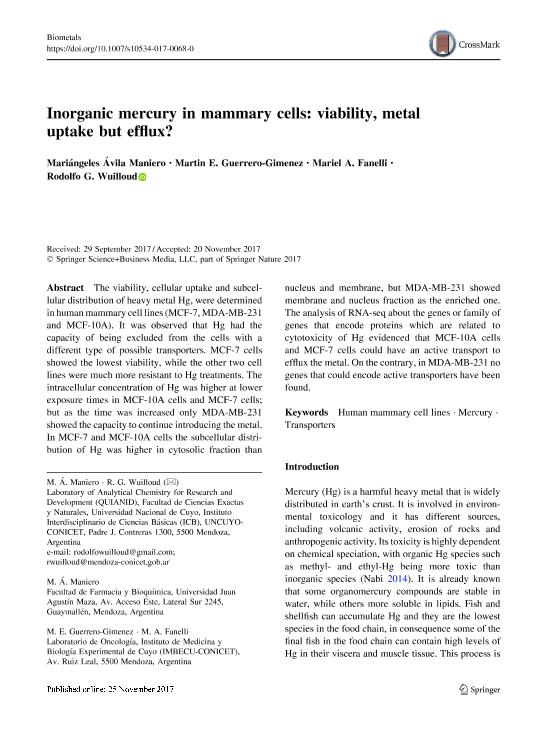Mostrar el registro sencillo del ítem
dc.contributor.author
Ávila Maniero, Mariángeles

dc.contributor.author
Guerrero Gimenez, Martin Eduardo

dc.contributor.author
Fanelli, Mariel Andrea

dc.contributor.author
Wuilloud, Rodolfo German

dc.date.available
2018-04-18T18:45:42Z
dc.date.issued
2017-11
dc.identifier.citation
Ávila Maniero, Mariángeles; Guerrero Gimenez, Martin Eduardo; Fanelli, Mariel Andrea; Wuilloud, Rodolfo German; Inorganic mercury in mammary cells: viability, metal uptake but efflux?; Springer; Biometals; 31; 1; 11-2017; 69-80
dc.identifier.issn
0966-0844
dc.identifier.uri
http://hdl.handle.net/11336/42522
dc.description.abstract
The viability, cellular uptake and subcellular distribution of heavy metal Hg, were determined in human mammary cell lines (MCF-7, MDA-MB-231 and MCF-10A). It was observed that Hg had the capacity of being excluded from the cells with a different type of possible transporters. MCF-7 cells showed the lowest viability, while the other two cell lines were much more resistant to Hg treatments. The intracellular concentration of Hg was higher at lower exposure times in MCF-10A cells and MCF-7 cells; but as the time was increased only MDA-MB-231 showed the capacity to continue introducing the metal. In MCF-7 and MCF-10A cells the subcellular distribution of Hg was higher in cytosolic fraction than nucleus and membrane, but MDA-MB-231 showed membrane and nucleus fraction as the enriched one. The analysis of RNA-seq about the genes or family of genes that encode proteins which are related to cytotoxicity of Hg evidenced that MCF-10A cells and MCF-7 cells could have an active transport to efflux the metal. On the contrary, in MDA-MB-231 no genes that could encode active transporters have been found.
dc.format
application/pdf
dc.language.iso
eng
dc.publisher
Springer

dc.rights
info:eu-repo/semantics/openAccess
dc.rights.uri
https://creativecommons.org/licenses/by-nc-sa/2.5/ar/
dc.subject
Human Mammary Cell Lines
dc.subject
Mercury
dc.subject
Transporters
dc.subject.classification
Otras Ciencias Biológicas

dc.subject.classification
Ciencias Biológicas

dc.subject.classification
CIENCIAS NATURALES Y EXACTAS

dc.title
Inorganic mercury in mammary cells: viability, metal uptake but efflux?
dc.type
info:eu-repo/semantics/article
dc.type
info:ar-repo/semantics/artículo
dc.type
info:eu-repo/semantics/publishedVersion
dc.date.updated
2018-04-16T13:47:11Z
dc.journal.volume
31
dc.journal.number
1
dc.journal.pagination
69-80
dc.journal.pais
Alemania

dc.journal.ciudad
Berlin
dc.description.fil
Fil: Ávila Maniero, Mariángeles. Universidad "Juan Agustín Maza"; Argentina. Universidad Nacional de Cuyo. Facultad de Ciencias Exactas y Naturales. Laboratorio de Química Analítica para Investigación y Desarrollo; Argentina
dc.description.fil
Fil: Guerrero Gimenez, Martin Eduardo. Consejo Nacional de Investigaciones Científicas y Técnicas. Centro Científico Tecnológico Conicet - Mendoza. Instituto de Medicina y Biología Experimental de Cuyo; Argentina
dc.description.fil
Fil: Fanelli, Mariel Andrea. Consejo Nacional de Investigaciones Científicas y Técnicas. Centro Científico Tecnológico Conicet - Mendoza. Instituto de Medicina y Biología Experimental de Cuyo; Argentina
dc.description.fil
Fil: Wuilloud, Rodolfo German. Consejo Nacional de Investigaciones Científicas y Técnicas; Argentina. Universidad Nacional de Cuyo. Facultad de Ciencias Exactas y Naturales. Laboratorio de Química Analítica para Investigación y Desarrollo; Argentina
dc.journal.title
Biometals

dc.relation.alternativeid
info:eu-repo/semantics/altIdentifier/url/https://link.springer.com/article/10.1007%2Fs10534-017-0068-0
dc.relation.alternativeid
info:eu-repo/semantics/altIdentifier/doi/https://doi.org/10.1007/s10534-017-0068-0
Archivos asociados
